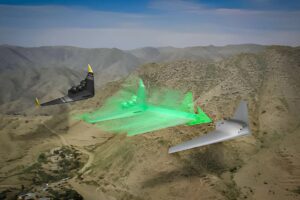ButSpeak.com
News which Matters.

DARPA’s XRQ-73, a hybrid-electric drone with stealth capabilities, designed for long-range missions. Learn about its advanced features and development goals.
DARPA has unveiled its latest technological marvel, the XRQ-73, a hybrid-electric drone designed under the Series Hybrid Electric Propulsion AiRcraft Demonstration (SHEPARD) program. Resembling a miniature B-21 bomber, the XRQ-73 aims to revolutionize military drone technology with its advanced capabilities in stealth and long-range endurance. Scheduled for its first flight by the end of the year, this X-plane demonstrates significant progress in the field of unmanned aerial vehicles (UAVs).
The XRQ-73 is the latest project in a series of advancements spearheaded by Northrop Grumman in collaboration with a consortium of aerospace innovators. It builds upon the success of the Great Horned Owl (GHO) program, initially developed under the Intelligence Advanced Research Projects Activity (IARPA) and supported by the Air Force Research Laboratory (AFRL). While the GHO weighed approximately 400 pounds (180 kg), the XRQ-73 is a Group 3 drone, capable of weighing up to 1,250 pounds (567 kg) and reaching top speeds of 250 knots (287 mph or 463 km/h).
One of the standout features of the XRQ-73 is its streamlined flying wing design, which enhances its stealth capabilities. Unlike the GHO, which had electric engines mounted on four pods atop its aft section, the XRQ-73 integrates these engines within its fuselage. This design minimizes its radar signature, making it ideal for missions deep into hostile territory while carrying significant payloads.
The SHEPARD program’s primary goal is to accelerate the maturation of hybrid-electric propulsion technology for military applications. “The idea behind a DARPA X-prime program is to take emerging technologies and burn down system-level integration risks to quickly mature a new missionized long endurance aircraft design that can be fielded quickly,” said Steve Komadina, the SHEPARD program manager. “The SHEPARD program is maturing a specific propulsion architecture and power class as an exemplar of potential benefits for the Department of Defense.”
This focus on rapid development and deployment is a hallmark of DARPA’s approach, aiming to have the XRQ-73 operational within 20 months. The hybrid-electric propulsion system is designed to provide the XRQ-73 with extended flight times and increased operational flexibility, crucial for modern military operations.
The XRQ-73 represents a significant leap forward in UAV technology, offering a blend of advanced stealth features and sustainable propulsion systems. Its development is closely watched by military analysts and aerospace engineers, as it promises to set new standards for future drone designs.